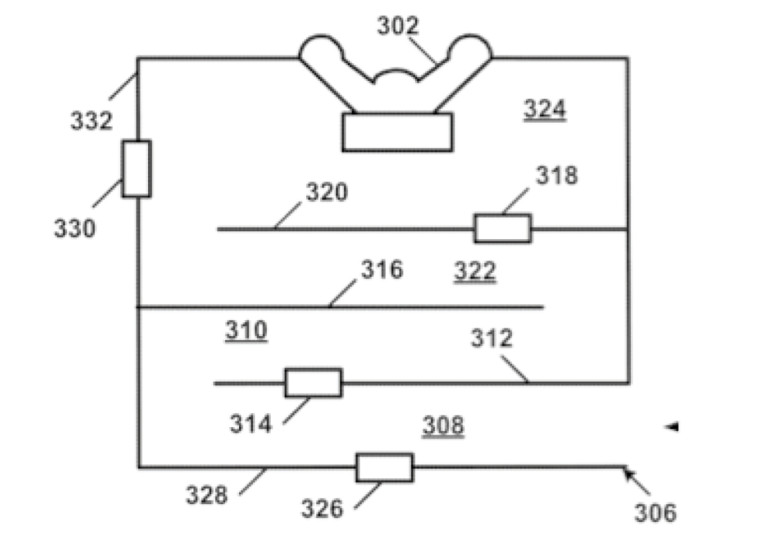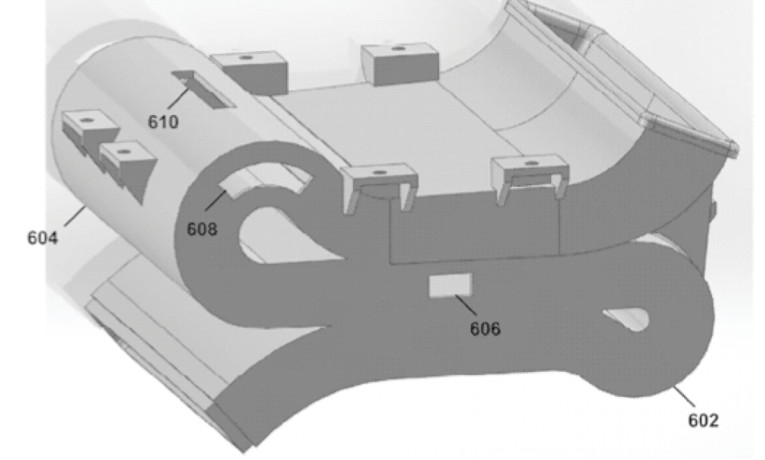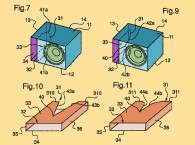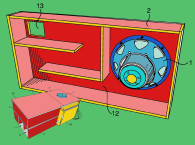
Acoustic Resistive Elements for Ported Transducer Enclosure
Patent Number: US20170188135A1
Inventors: Antonio M. Lage (Ashland, MA); Said Boluriaan; (Acton, MA); Eric C. Mitchell (Upton, MA) ; Ray Scott Wakeland; (Marlborough, MA); and John H. Wendell (Westford, MA)
Assignee: Bose Corp., Framingham, MA
Filed: December 28, 2015
Current CPC Class: H04R 1/2849 20130101
Granted: March 6, 2018
Number of Claims: 24
Number of Drawings: 6
Abstract from Patent
An apparatus includes an enclosure capable of receiving a transducer for converting electrical signals into audible signals. The apparatus also includes one or more structures within the enclosure defining one or more channels, each channel having one end located within the enclosure and another end that is external to the enclosure. The apparatus also includes an acoustic resistive element located in the one of the one or more structures, the acoustic resistive element being capable of changing the acoustic characteristics of at least one of the one or more channels within the enclosure.
Independent Claims
1. An apparatus comprising: an enclosure defining an acoustic volume, the enclosure capable of receiving a transducer for converting electrical signals into audible signals; at least two structures within the enclosure defining corresponding channels, each channel having one end located within the enclosure and another end that is external to the enclosure; and an acoustic resistive element located on a wall shared by two adjacent structures of the at least two structures, the acoustic resistive element configured to change acoustic characteristics of the channels corresponding to the two adjacent structures within the enclosure.
12. An apparatus comprising: a transducer for converting electrical signals into audible signals; an enclosure that includes the transducer and defines an acoustic volume; at least two structures within the enclosure defining corresponding channels, each channel having one end located within the enclosure and another end that is external to the enclosure; and an acoustic resistive element located on a wall shared by two adjacent structures of the at least two structures, the acoustic resistive element configured to change acoustic characteristics of the channels corresponding to the two adjacent structures within the enclosure.
Reviewer Comments
One of the issues with smaller bass reflex enclosure systems is that when they are reduced in enclosure volume, the port, for a given cross-sectional area, must grow in length to maintain the same tuning frequency. In a small enclosure, there may not be adequate length in the longest dimension of the enclosure to fit in a straight port of the required length. Any extension in length, therefore, must be extended outside of the enclosure or folded within the enclosure. Extended lengths exhibit pipe resonances and curving or folding of the port has been found to cause losses and turbulence, and historically has been avoided where possible.
The patent under review offers a solution from a group of engineers at Bose Corp. Over the years (decades, actually) Bose has gone through an interesting evolution of bass reflex and band-pass architectures, as illustrated in the Figure 1.

Here are the patents that correspond to the enclosures shown in the drawing in Figure 1. Starting in 1976 with US Patent 4,146,744, “Low Q Multiple in Phase High Compliance Driver Ported Loudspeaker Enclosure” by Joseph Veranth, Bose filed its first patent on a single tuned, bass reflex enclosure adapted to its successful Bose 901 loudspeaker. Next, in 1983, with US Patent 4,549,631, “Multiple Porting Loudspeaker Systems,” Amar Bose filed for a parallel, dual chamber, dual tuned bandpass bass reflex enclosure. The third iteration came in 1990, with US Patent 5,092,424, “Electroacoustical Transducing with At Least Three Cascaded Subchambers” by William Schreiber at Bose, who filed for a triple chamber, triple tuned bandpass bass reflex enclosure. This is where Bose reached the peak of complexity for its bass reflex systems. That was followed up in 2011 with US Patent 8,459,404 “Loudspeaker” by Michael Murray, et al, when Bose reverted back (advanced?) to patenting a dual chamber, dual tuned bandpass bass reflex enclosure system.
Now in 2017 (filed in 2015), the currently reviewed patent application publication — US Patent 2017/0188135, “Acoustic Resistive Elements for Ported Transducer Enclosure” by Antonio M. Lage, et al, Bose Corp. — has gone back to the single chamber, single tuned, bass reflex enclosure system (see Figure 2).

The parallel, dual-tuned band pass patent concept was first shown as a prior art drawing in the 1934. A. D’Alton’s patent, US Patent 1,969,704, “Acoustic Device” and was described as “a known form of loudspeaker” but nobody knows who actually built these devices. The first to actually file for a patent on the parallel, dual-chamber, dual-tuned, bandpass reflex, was Bernhard Puls, in European Patent EP 012625, “Lauitsprecherbox Mit Integriertem Akustischem Bandpassfilter” filed May 13, 1983, five months before Bose filed the dual-tuned, dual-chamber system. The single-tuned form of bandpass was first disclosed in 1954, in US Patent 2,689,016, “Sound Reproducing System” by H. C. Lang, a first employer of audio Hall of Famer, Henry Kloss.
What actually kicked off the more modern fascination with bandpass enclosures was an illuminating Audio Engineering Society (AES) paper by KEF’s Laurie Fincham, “A Bandpass Loudspeaker Enclosure,” from the May 1979, 63rd Convention. KEF had intended to patent Fincham’s work, but during a literature and patent search by Raymond Cooke (KEF’s founder and CEO), it was discovered that the original 1954 Lang patent anticipated the basic band-pass structure.
Following the Fincham paper, the basic forms of each of the current bandpass architecture types were quickly established over the next few years, with the initial single-tuned and parallel dual-tuned forms, of Fincham and Puls, followed by the series dual-tuned bandpass, put forth in US Patent 4,875,546 “Loudspeaker With Acoustic Band-Pass Filter” by Palo Krnan of Teledyne (AR), the air-coupled, Augmented Passive Radiator/Acoustic-Lever type bandpass shown in US Patent 4,387,275 “Speaker and Speaker System” by Yasuomi Shimada, et al, of Matsushita, the manifold type bandpass disclosed in US Patent 4,733,749 “High Output Loudspeaker for Low Frequency Reproduction” by Raymond J. Newman of Electro-Voice, Inc. and the quarter wave pipe/bass reflex hybrid bandpass architecture, as disclosed in US Patent 5,197,103, “Low Sound Loudspeaker System” by Junichi Hayakawa, of Kabushiki Kaisha Kenwood.
These tend to represent the baseline for substantially all bandpass systems that have been developed to date, with variations representing reformed or combined versions of these original architectures. Some of the predicted advantages of the multi-tuned bandpass systems were that of greater efficiency for narrow bandwidth alignments, reduced distortion due to the low-pass acoustic output filter of each tuned mass/compliance, and the transducer excursion overload reduction due to there being a displacement minimum at each tuning frequency.
To give a short assessment of each of these attributes: First, the efficiency advantage for a low ripple design was quite small, to non-existent, in all but very narrow band devices. Second, since the low-pass characteristic of the acoustic filters are on the output of the transducer, they can be quite effective at reducing transducer distortion at high drive levels, with some of the triple tuned systems exhibiting low pass stop band acoustic slopes of approximately 30 dB per octave.
This is effective for low-passing the program and distortion output of the woofer system, which can also be useful for raising the subwoofer crossover to a higher frequency for use with smaller satellites while minimizing disturbance of spatial imaging. (Low subwoofer crossover frequencies are less important that being sure that the subwoofer program material and distortion components are adequately suppressed above a given frequency, for which steep, low-pass acoustic filters can be very useful.)
But, since the port operates on the output of the filter, any port turbulence or pipe resonances tend to be even more apparent than in non-bandpass systems, due to smaller chambers requiring greater acoustic mass (longer and/or smaller cross sectional area) for a given tuning frequency, and the fact that the pipe resonances operate above the pass band of the subwoofer bandwidth and standout more clearly without the masking of a full range driver (it is masked somewhat when used in conjunction with the upper range satellite speakers).
Third, the multiple tunings, with multiple frequencies of displacement minima, would suggest that total system excursion would be reduced with these systems, as compared to a single tuned bass reflex enclosure. But, unfortunately, in the real-world application, this does not turn out to be true.
If one observes the excursion vs. frequency of a standard single-tuned bass reflex loudspeaker, one will see that it reaches an excursion minimum at the tuning frequency FB. At approximately 1.4 × FB, the system reaches its highest excursion frequency in the pass band and then the excursion falls at 12 dB octave of increased frequency.
The original Bose 302 dual-tuned bandpass professional woofer system was tuned at 55 Hz and 110 Hz. Based on tests and Bose’s own published displacement vs. frequency curves, it is illustrated that the displacement minimum at the 55 Hz FB is the same as a standard bass reflex tuned to 55 Hz.
But, as the frequency of 1.4 × FB is approached, where the excursion of the standard bass reflex reaches a maximum, the dual tuned bandpass requires at least 3 dB of additional excursion to maintain a flat passband which means that the dual tuned bandpass actually has a greater Xmax requirement for a given output, the opposite of what is expected. And at the upper tuning frequency of 110 Hz, the excursion requirement has fallen dramatically for either system, so that any amount of reduced displacement at the upper tuning frequency of the dual-tuned bandpass is more than swamped by the greater excursion requirement between the two tuning frequencies.
Ultimately, the multi-tuned bandpass system has fallen out of favor for all but very few applications for practical reasons, and one can see why Bose might have evolved its systems back to a more advanced, single Helmholtz tuned bass reflex.
A closer look at the new Bose device (see Photo 1) shows a bass reflex enclosure with a port that is folded and extended in length to the degree that the port represents more than 50% of the total enclosure volume, but it would also develop significant pipe resonances at frequencies well into the lower part of the passband (see Figure 3).

As background, Helmholtz bass reflex and quarter wave pipe systems, in their pure forms, are usually characterized as two distinct system types. In actuality, there is an infinite spectrum of Helmholtz-to-Quarter wave pipe systems that morph from one to the other depending on how long the “port/pipe” is vs. how large the coupling chamber is compared to the total enclosure volume.
The classic, pure bass reflex system would be one that uses a large enclosure with a port that is simply a hole-opening in the enclosure’s wall with the length of the port being equal to the thickness of the enclosure wall, or effectively a zero length pipe, in terms of developing pipe resonances. On the spectrum’s opposite end is that of a pure, quarter-wave pipe, with the active transducer coupled one end of an elongated, constant diameter, open pipe.
Research that originated at Philips Corp. for bass reflex bandpass systems with long ports (see “Band-Pass Loudspeaker Enclosure with Long Port” by J.A.M. Nieuwendijk, presented at the 94th AES Convention in 1993, along with the associated patent US Patent 5,261,006, “Loudspeaker System Comprising a Helmholtz Resonator Coupled to an Acoustic Tube”) has shown that for a given enclosure volume one can trade a reduction in enclosure volume for increasing port length. It has been known that one can use this approach to maintain tuning frequency, but in some of the middle forms along the spectrum the system efficiency suffers.
However, when extended to one extreme of a long pipe with a small coupling volume, an enclosure system is created where the lower resonant frequencies of the elongated pipe/port approach that of the Helmholtz tuning frequency, FB, which can provide an increase in capability, particularly in active systems where electronic equalization is available to compensate for high ripple alignments.
Ronald Aarts, also from Philips, has extended the work of Nieuwendijk to a non-bandpass, bass reflex system and has created a new set of alignments that result in an increase in system output over prior art systems albeit, in exchange for exaggerated ripple in the pass-band. Aarts work can be found in the Journal of the Audio Engineering Society (JAES) as “Efficient Resonant Loudspeakers with Large Form-Factor Design Freedom” Volume 54, Number 10, October 2006.
As previously mentioned, a downside to these elongated-port Helmholtz-reflex systems is the creation of a series of pipe resonances that can start as low as FB and extend well up into the passband. We have seen this addressed through various means in some of the recent patent reviews and in the patent of this review Bose has introduced another solution to address the issue.
The approach that the Bose system uses is to establish a number of points along the elongated port where an opening is fabricated into the wall of the port and an acoustically resistive element is placed in that opening (e.g., a wire mesh and/or an absorbent material like acoustic foam). These openings are placed in several positions within the port structure. One approach is to place the resistive element with the opening between two channels of the folded port (see 314 and 318 in Figure 3), wherein the effect may be to locate the variations in pressure throughout the port at an undesirable pipe resonance frequency and to create the effect of an acoustic short across the port wall to reduce output at that frequency. Additionally, Bose has specified the resistive opening may be formed through the port wall into the internal enclosure volume (see 318 in Figure 3), or formed through a port wall and exiting to the environment external to the enclosure (see 326 in Figure 3).

A similar approach has been disclosed by Kazunari Fiurukawa of Yamaha in US Patent 5,109,422, “Acoustic Apparatus” wherein a straight port has a cutout through the sidewall of the port connecting into the internal enclosure volume, with a resistive element place over the opening and positioned so as to cancel parasitic pipe resonances. Nicolaas B Roozen, et al, of US Philips shows a more advanced version of the same concept in US Patent 6,275,597, “Loudspeaker System Having a Bass-Reflex Port.”
By comparison the Bose is optimized for a much longer port, which is also folded within the enclosure with the novelty being the cross-coupled resistive openings between the different channels of the folded port. Unfortunately, Bose does not disclose any particular instructions on the optimal position of the resistive openings along the length of the port to address the specific resonances of concern, so it leaves one to determine the desired results empirically.
Bose’s first product with the technology is a subwoofer with a 10” woofer in an approximately 1 ft3 enclosure, under the name “Bose Acoustimass 300 Subwoofer with Quiet Port Technology,” which appears to have been well received. As much as the development of the Bose bass-reflex systems may, on the surface, appear to be a combination of evolution and devolution, the fact is each of the systems has embodied advancements that enabled them to outperform their predecessors and advance their bass technology in a manner that didn’t stay stuck in the established in-house theology, as happens at some companies.
The new system appears to be based on sound principles of an actively equalized subwoofer with the optimization of a small subchamber combined with an elongated port and the formation of a folded port structure that minimizes losses at the folds, and controls parasitic pipe resonances with a novel, cross-coupled resistive element in a manner that should result in a high performance subwoofer that may very well be superior to any of the previous Bose low-frequency systems. (As additional information, Bose has received a final rejection from the patent office on this application, and in its first appeal, the US Patent and Trademark Office examiner found additional prior art to challenge the case, and it remains unclear as to whether the application will be granted.) VC
Note: The application was granted in March 6, 2018, and this article was updated.
This article was originally published in Voice Coil, October 2017.






